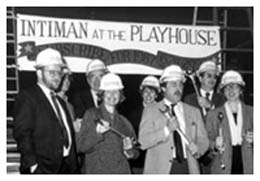On June 10, 1987, Intiman Theatre opens George Bernard Shaw's (1856-1950) Man And Superman as the first production of its 15th season and the first to be put on in the newly renovated Seattle Playhouse at the Seattle Center. The performance publicly marks the company's return to stability and financial health after several years in which its future existence was in question.
Intiman's Early Years
Margaret Booker (b. 1942) founded Intiman Theatre in Kirkland in 1972. Intiman's home from 1975 to 1984 was the Seattle Repertory Theatre's alternate facility, Second Stage. Second Stage was located in the former Seattle Town and Country Club at 8th Avenue and Pike Street in downtown Seattle. Intiman used the venue during the summer months when Seattle Rep was not in season.
In 1984 the Second Stage facility was slated for demolition to make way for the Washington State Convention Center and the Intiman was forced to vacate. A plan to renovate the Mann Building at 3rd Avenue and Pike Street to be the Intiman's new home fell through. The company's financial picture grew dire. In the summer of 1985 the Intiman mounted a three-play season at the Seattle Central Community College's Broadway Performance Hall. Margaret Booker, the Intiman's founder and artistic director, left the company as did general manager Simon Seigl. Elizabeth Huddle and Peter Davis joined the Intiman as (respectively) artistic director and managing director.
A Playhouse Home
On April 21, 1986, the Seattle City Council agreed to give the Intiman an extended lease on the Seattle Playhouse at the Seattle Center. The Seattle Playhouse was built in just 34 days in 1962 for the Century 21 Seattle World's Fair. Actor Hal Holbrook (b. 1925), one of the many performers to appear at the Playhouse during the world's fair, is said to have suggested that the Playhouse would make an excellent home for a repertory theater company. A number of prominent Seattleites including Seattle businessman and arts patron Bagley Wright (1924-2011) took up this cause, organizing the company they called the Seattle Repertory Theatre. Despite having a similar name, the Seattle Repertory Theatre had no connection with an earlier Seattle theatrical enterprise, Florence and Burton James's Seattle Repertory Playhouse in the University District.
The Seattle Repertory Theatre opened its first production at the Seattle Playhouse on November 13, 1963, and continued to use the facility until 1982 when it moved into the Bagley Wright Theatre next door to the Playhouse. The Bagley Wright Theatre, built on the site of the Century 21 World's Fair's Foreign Commerce and Industry Center was the first new construction on the Seattle Center grounds since 1962.
The Playhouse had been without a permanent tenant since the Seattle Rep moved out. It had not been substantially updated since its construction and had an auditorium that seated 895. The Intiman, named in homage to August Strindberg's (1879-1912) Intima Teatern or Intiman in Stockholm and known for producing classic drama on an intimate scale, accepted the facility gratefully and planned to renovate.
Getting Close
Seattle Times drama critic Wayne Johnson described the $1.2 million renovation then in progress in an article on March 29, 1987:
"In the old proscenium-stage, 895-seat Playhouse, the theater's back wall was 75 feet from the stage apron. In the remodeled 405-seat theater, the comparable distance is 36 feet. And the new theater has only 1/3 as much cubic volume of space as the old Playhouse ... The stage will thrust into the house 16 feet out from the old stage apron. The seats are arranged in 11 rows in a banked semi-circle around the playing area. Access to the seats is by two outside aisles and two inner aisles ... . There are two stage exits which go under the audience. They are called vomitoriums, after similar exits in old Roman theaters ... . The only parts of the old Playhouse still visible are an overhead catwalk and portions of the two side walls" ("Intiman Recovering Nicely...").
Reducing the depth of the stage brought the actors closer to the audience and created a much-needed backstage area.
All Roads Lead To The Actor
Elaborating on the Intiman's commitment to fostering an intimate theatrical experience between audience and performers, managing director Peter Davis told Wayne Johnson, "In our theater, all roads lead to the actor because that's the kind of theater we are."
Richard Hay, designer of the Angus Bowmer Theatre at the Oregon Shakespeare Festival in Ashland, Oregon, designed the renovation and Robert Schnieder of Baumgardner Architects in Seattle implemented it. The 400 theater seats had been culled from the old Playhouse seats and re-installed in the new configuration. In 1998 these seats were replaced with new ones. The Intiman now (2006) seats approximately 446, depending on the configuration of seats around the thrust stage for each production.
The move enabled the Intiman to house the company's shop, production, rehearsal, performance, and administrative branches in the same facility for the first time it its history.
The City of Seattle spent $212,000 in bond-issue funds to install an elevator, cut a wheelchair-accessible door in the Playhouse's west wall, and add two new restrooms. The Intiman mounted a capital campaign to cover the remaining cost of renovation.

